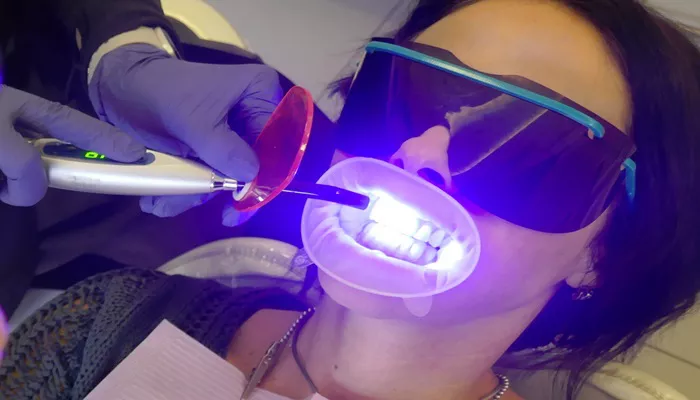Teeth whitening has become an increasingly popular cosmetic dental procedure, with many people seeking brighter, whiter smiles. One of the most common methods used in professional teeth whitening is the application of light. This article will explore the different types of light used for teeth whitening, their effectiveness, and the potential risks associated with their use.
What Is Teeth Whitening?
Teeth whitening is a process that aims to remove stains and discoloration from the surface of the teeth, resulting in a whiter and brighter appearance. There are several methods available, including over-the-counter products, professional treatments, and combinations of both. Professional teeth whitening treatments often involve the use of light to enhance the whitening process.
Types of Light Used for Teeth Whitening
Several types of light are used in professional teeth whitening procedures. The most common are:
1. LED (Light-Emitting Diode) Light
LED light is one of the most widely used light sources for teeth whitening. It emits a specific wavelength of light that activates the whitening agent, typically hydrogen peroxide or carbamide peroxide, to break down stains and discoloration on the teeth.
2. Halogen Light
Halogen light is another type of light used in teeth whitening. It emits a broad spectrum of light, including visible light and some ultraviolet (UV) light. The heat generated by the halogen light helps to activate the whitening agent and enhance the whitening process.
see also: How Much Is Teeth Whitening in Arizona?
3. Laser Light
Laser light is a highly focused, intense light source that is sometimes used in professional teeth whitening. It emits a specific wavelength of light that is absorbed by the whitening agent, causing it to break down stains and discoloration more effectively.
Effectiveness of Light-Activated Teeth Whitening
The effectiveness of light-activated teeth whitening depends on several factors, including the type of light used, the concentration of the whitening agent, and the duration of the treatment. Studies have shown that light-activated teeth whitening can be effective in removing surface stains and discoloration, resulting in a whiter and brighter smile.
However, it’s important to note that the long-term effects of light-activated teeth whitening are still being studied. Some research suggests that the use of light may not significantly enhance the whitening process compared to using the whitening agent alone.
Potential Risks of Light-Activated Teeth Whitening
While light-activated teeth whitening is generally considered safe when performed by a qualified dental professional, there are some potential risks associated with its use:
1. Tooth Sensitivity
One of the most common side effects of teeth whitening is tooth sensitivity. The whitening agent and the heat generated by the light can cause temporary sensitivity to hot and cold temperatures.
2. Gum Irritation
If the whitening agent comes into contact with the gums, it can cause irritation and inflammation. Dental professionals take precautions to minimize this risk, such as using a rubber dam or other protective barriers.
3. Enamel Damage
There is some concern that the use of light during teeth whitening may cause damage to the tooth enamel. However, more research is needed to determine the long-term effects of light-activated teeth whitening on tooth structure.
Preparing for Light-Activated Teeth Whitening
Before undergoing light-activated teeth whitening, it’s important to consult with a dental professional to ensure that the procedure is appropriate for your individual needs. During the consultation, your dentist will:
Examine your teeth and gums to ensure that they are healthy and suitable for whitening.
Discuss your expectations and goals for the procedure.
Explain the potential risks and side effects of light-activated teeth whitening.
Provide instructions on how to prepare for the procedure, such as avoiding certain foods or beverages.
The Teeth Whitening Procedure
During a light-activated teeth whitening procedure, your dentist will:
Clean your teeth to remove any plaque or debris.
Apply a protective barrier to your gums to prevent irritation.
Apply the whitening agent to your teeth.
Activate the whitening agent with the light source, typically for 15-30 minutes.
Repeat the process as necessary, depending on the desired level of whitening.
After the procedure, your dentist will provide instructions on how to care for your teeth and minimize any side effects, such as sensitivity.
Maintaining Your Whiter Smile
To maintain your whiter smile after light-activated teeth whitening, it’s important to:
Practice good oral hygiene, including brushing and flossing regularly.
Avoid foods and beverages that can stain your teeth, such as coffee, tea, red wine, and dark-colored fruits and vegetables.
Use a whitening toothpaste or mouthwash to help maintain your results.
Schedule regular dental check-ups and cleanings to keep your teeth healthy and bright.
Conclusion
Light-activated teeth whitening is a popular and effective method for removing stains and discoloration from the teeth.
While several types of light are used, including LED, halogen, and laser light, more research is needed to determine the long-term effects of light-activated teeth whitening on tooth structure and enamel. It’s important to consult with a dental professional to ensure that the procedure is appropriate for your individual needs and to minimize any potential risks or side effects.

